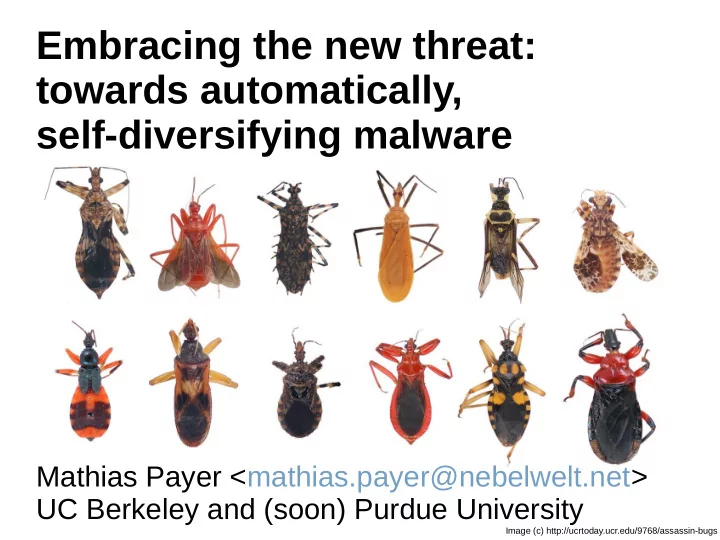

Embracing the new threat: towards automatically, self-diversifying malware Mathias Payer <mathias.payer@nebelwelt.net> UC Berkeley and (soon) Purdue University Image (c) http://ucrtoday.ucr.edu/9768/assassin-bugs
Malware landscape is changing Image (c) Wikimedia
The ongoing malware arms race Generate new malware instance Signatures Attack a bunch updated of targets Malware AV vendor analysis gets first sample
Defense limitations ● Newly diversified samples are not detected – Basically a “new” attack ● New malware spreads fast – Time lag between analysis and updated signatures ● Can we automate this process?
Fully automatic diversity ? *.cpp Compiler Malware Malware Malware
Outline State of the art: Malware detection A new threat: Malware diversification Possible mitigation: Better security practices
State of the art: Malware detection Image (c) Wikimedia
Malware detection is limited ● Performance – Don't slow down a user's machine (too much) ● Precision – Behavioral, generic matching ● Latency – Time lag between spread and protection
Detection mechanisms Image (c) Wikimedia
Signature-based detection ● Compare against database of known-bad – Extract pattern – Match sequence of bytes or regular expression ● Advantages – Fast – Low false positive rate ● Disadvantages – Precision limited to known-bad samples
Static analysis-based detection ● Search potentially bad patterns – API calls – System calls ● Advantages – Low overhead ● Disadvantages – False positives – Based on well-known heuristics
Behavioral-based detection ● Execute “file” in a virtual machine – Detect modifications ● Advantages – Most precise ● Disadvantages – High overhead – Precision limited due to emulation detection
Summary: Malware protection ● Arms race due to manual diversification – Signature-based techniques loose effectiveness ● Cope with limited resources – On the target machine, for the analysis, and to push new signatures/heuristics ● No perfect solution – Either false positives and/or negatives or huge performance impact
New threat: Malware diversification Image (c) Wikimedia
Software diversification ? *.cpp Compiler Program Program Program
C/C++ liberties ● Data layout changes – Data structure layout on stack – Layout for heap objects (limited for structs) ● Code changes – Register allocation (shuffle or starve) – Instruction selection – Basic block splitting, merging, shuffling
Malware diversification ● Generate unique binaries – Minimize common substrings (code or data) – Performance overhead not an issue ● Diversify code and data layout ● Diversify static data as well
Implementation ● Prototype built on LLVM 3.4 – Small changes in code generator, code layouter, register allocator, stack frame layouter, some data obfuscation passes ● Input: LLVM bitcode ● Output: diversified binary ● Source: http://github.com/gannimo/MalDiv
Similarity limitations Common subsequences in diversified binaries 1000000 400.perlbench 401.bzip2 429.mcf 100000 433.milc Number of subsequences (log scale) 444.namd 445.gobmk 10000 450.soplex 453.povray 456.hmmer 1000 458.sjeng 462.libquantum 464.h264ref 100 470.lbm 471.omnetpp 473.astar 10 482.sphinx perlbench vs. bzip2 perlbench vs. gobmk 1 soplex vs. omnetpp 2 4 6 8 10 12 14 16 18 20 22 24 26 28 30 32 34 36 38 40 42 44 46 48 50 52 54 56 nmap 1 3 5 7 9 11 13 15 17 19 21 23 25 27 29 31 33 35 37 39 41 43 45 47 49 51 53 55 57 simple port scanner Lenght of subsequence
Demo ● Simple hello world – Let's see how far we can push this! #include <stdio.h, string.h> const char foo[] = "foobar"; char bar[7]; int main(int argc, char* argv[]) { strcpy(bar, "barfoo"); printf("Hello World %s %s\n", foo, bar); printf("Arguments: %d, executable: %s\n", argc, argv[0]); return 0; }
Scenario 1: malware generator ? *.cpp Compiler Malware Malware Malware
Scenario 2: self-diversifying MW Malware Malware* Malware* Malware* LLVM Opt LLVM Opt* LLVM Opt* LLVM Opt* Malware bc Malware bc* Malware bc* Malware bc* LLVM bc LLVM bc* LLVM bc* LLVM bc*
Possible mitigation: Better security practices Image (c) Wikimedia
Mitigation ● Recover high-level semantics from code – Hard (and results in an arms race) ● Full behavioral analysis – Harder ● Prohibit initial intrusion – Fix broken software & educate users – Hardest
Conclusion Image (c) Wikimedia
Conclusion ● Diversity evades malware detection – Fully automatic, built into compiler – No need for packers anymore ● Adopts to new similarity metrics ● New arms race between defenders and compiler writers ● Don't rely on simple, static similarity!
Questions? Mathias Payer <mathias.payer@nebelwelt.net> Project: https://github.com/gannimo/MalDiv Homepage: https://nebelwelt.net
Recommend
More recommend